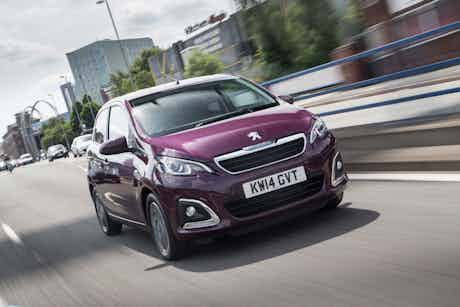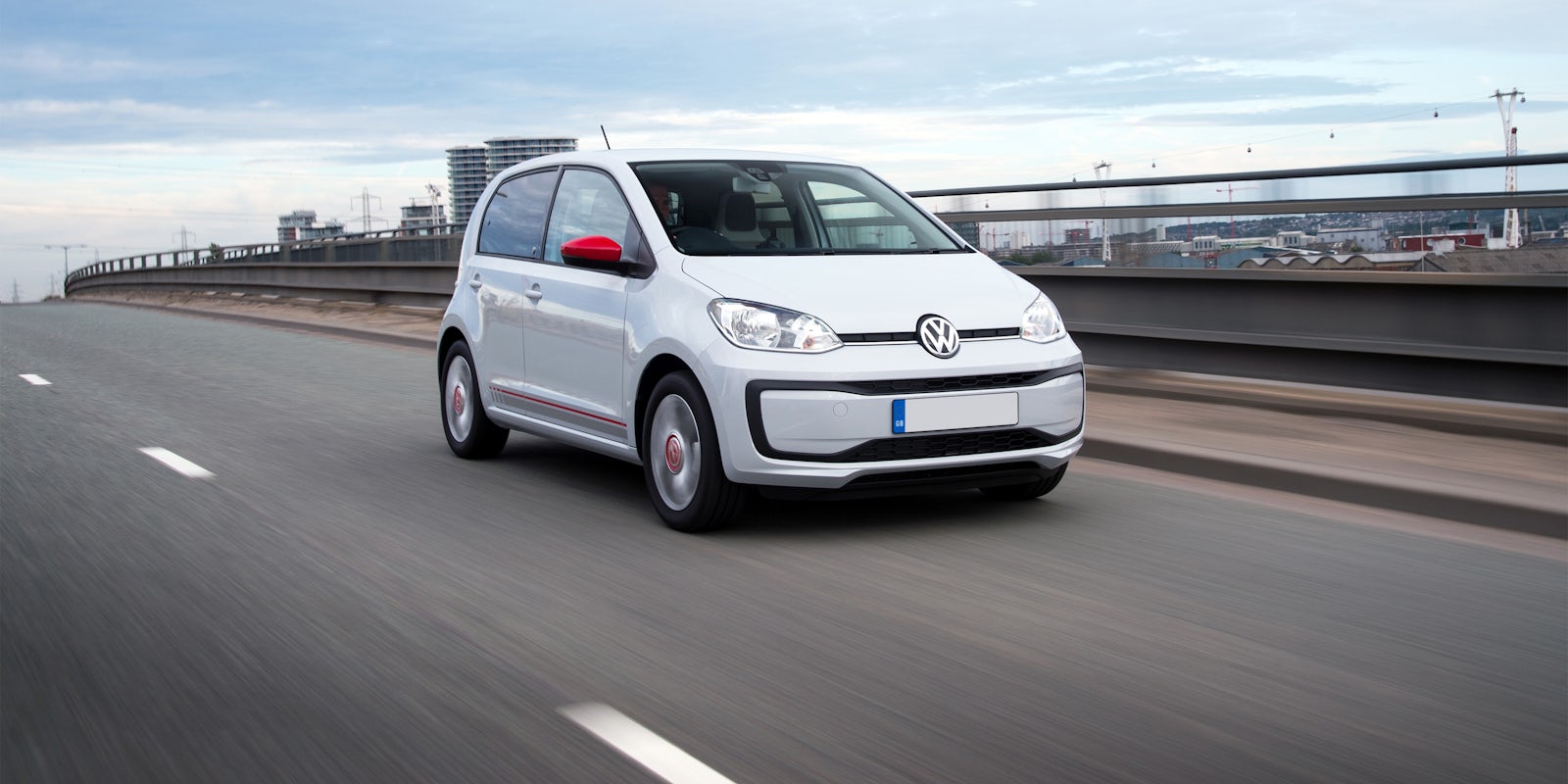Volkswagen Up vs Peugeot 108 – which is best?
September 18, 2014 by Sean Cooper

Small cars have come a long way in recent years and Peugeot and Volkswagen both have long, illustrious histories in the sector. But traditional companies like these two certainly don’t have it all their own way these days with strong competition from the likes of Kia, Hyundai, Fiat and others.
But these two European giants are still among the first manufacturers many of us will turn to if we are thinking of buying a small car. As such, we’ve put together a direct comparison between the Peugeot 108 and the VW Up to help you choose your perfect city car.
Since writing this article we’ve driven the Peugeot, so read our thoughts why the 108 beats the Up in five important areas.
Styling

If we’re to go along with traditional brand stereotypes you’d probably expect the VW Up to look conservative, practical and efficient and the Peugeot 108 to be sexy, stylish and maybe a little naughty at times. And while we do our best to avoid tired stereotypes, that’s pretty much what you’ll find with these two.
While constrained to many of the same body panels as its Toyota Aygo and Citroen C1 cousins, Peugeot’s designers have clearly worked hard on giving the 108 it’s own individual appeal. Despite its market positioning, the 108 manages to look quite expensive, particularly in the right colour, and Peugeot offers a range of fancy graphics to help it stand out from others in the supermarket car park.

Volkswagen takes a different route to city car bliss. It’s certainly got more personality than some of Volkswagen’s more grown-up products, and there’s real youthful appeal here. Pick an obviously-fashionable colour like white and there’s a bit of iPod style to the Up, particularly around the rump where an all-glass tailgate sits (a detail common to the 108). It’s largely designed for lower costs, but it looks like a high-end product.
Which is most attractive? Beauty is really in the eye of the beholder here. You might say the Up appeals more to logical types, those with a keen eye for architectural design who find appeal in minimalism. The 108 has a Gallic quality that might attract more artistic-minded buyers, those who appreciate graphics, vibrant colour and philosophy. Damn, there are those stereotypes again…
Interior and practicality

Volkswagen interiors tend to score highly for quality, and the Up is no exception. The quality of the materials and the overall layout is much better than many of its competitors – even if Hyundai has caught up a little with the latest i10 – and there’s a pleasing minimalist quality to the interior that replicates that of the outside. There’s a simple dashboard with logical controls and an airy feel, and the steering wheel is a nicely-formed shape wrapped in either plastic or leather, depending on spec.
There’s probably a bit more legroom in the Up than you may expect from the diminutive dimensions, and two adults wouldn’t be too uncomfortable in the back for a quick dash across town. Those up front have even more space and VW can supply you a handy removable sat-nav system that plugs into the top of the dash, so you won’t be afraid to travel further afield.

The old Peugeot 107 wasn’t exactly luxurious on the inside (in fact, it was a bit naff), but this is a shortcoming that the French manufacturer has worked hard to overcome with all its latest models. The materials and the cockpit layout of the 108 are a big step-up from previous incarnations with higher quality surfaces and switchgear that brings the 108 within a whisker of its German rival. One thing the Peugeot offers that the VW doesn’t is the option of a sliding fabric roof – a great way to introduce a little fresh air to the cabin.
There’s even a 7-inch touchscreen in the centre of the dash on all-but the entry-level Access models, giving access to many of the car’s functions. If you want sat-nav in the Pug though, it’s up to your smartphone. Using a system called MirrorLink, you can hook up car with phone and use some of your smartphone’s functions through that central display.
Driving

Buyers are increasingly demanding in what they expect from a new car, and won’t go easy on cars like the Up and 108 just because they’re inexpensive to buy. City cars will live a hard life, too – they must suffer wheel-spinning getaways, bumped kerbs, parking dings and lots of short-distance journeys that really test a car’s engine and gearbox.
Even though cars like the 108 and the Up are designed for nipping around towns and cities, there may still be time when you’ll want to leave the car’s natural environment and give it a run in the country. Happily, either car is capable of longer distances, though the VW might prove more relaxing on the move – its three-cylinder engines are quieter than those offered by Peugeot, a little smoother too, and despite low outputs (59bhp and 74bhp) there’s enough power to whizz along at motorway speeds, provided you make best use of the snicky gearbox.

Blast around in the Peugeot and you’ll be accompanied by plenty of noise, regardless of whether you’ve opted for the 1.0 or the 1.2 engine. Some of that is designed-in sportiness (which may appeal) but it’s not quite the grown-up experience of the Up. The 1.2 does offer a bit more urge, however.
Both cars are predictably excellent in the city. There’s more than enough acceleration available, visibility is pretty good (better in the Up, by a shade) and each handles ruts and bumps (again, the VW is a touch better here). The Peugeot feels sportier to drive, the VW slightly more relaxed. Take your pick!
Engines

Rather than design an all-new 1.0-litre engine, Peugeot has revised the unit previously found in the 107, and like its compatriots from Toyota and Citroen, bunged it under the bonnet of the latest small car. It develops 68 horsepower, returns up to 74.3 mpg and if you’re liberal with the throttle and swift with the gearbox, will thrum to 60mph in 14.3 seconds.
If you’ve got the budget, the smart money will probably go on the new 1.2-litre Puretech lump, as found under the bonnet of the larger 208. It’s also a 3-cylinder engine and returns a healthier 81bhp – and perhaps more importantly, 86 lb-ft of torque rather than 71 lb-ft offered by its little brother. Best of all, economy is still good enough (65.7mpg) that you won’t pay a penny on VED.

All Up models come with a 1.0-litre 3-cylinder engine, in both 59hp and 74hp flavours. Around town, you’re best off opting for the cheaper, lower-power model, since each car has an identical torque figure at its peak. You only feel the benefits of the larger lump on the open road.
Unlike the Peugeot, not all Ups sneak into the free VED band A. However, it’s probably not worth spending the hundreds of quid extra to get the Bluemotion Tech models that do, since you’ll never make back your money in savings – Band B is still only twenty quid a year! The Up’s engine is quieter than its Peugeot equivalent and should return similar real-world economy. Bank on around 55-60mpg in regular driving, a little less in town.
Value for money

The cheapest 108 is £8,245 to the Up’s £8,635. From there, it’s down to personal preference as realistically it’s a close-run thing. VW promises the strong residuals, Peugeot higher equipment levels. Peugeot has the better economy, by a tad, but the Up falls into lower insurance groups. The two trade places for value in several key areas.
Although Peugeot says it intends to stop heavy discounting of its vehicles as it pursues a more upscale image for its cars, you just know that a 108 is going to lose an awful lot more of your hard-earned cash in depreciation than the Up. VWs similarly lose value slower than many rivals.
But if you get your kicks from personalisation, the Peugeot will grab you a lot faster than the Up. Between cool colours, graphics packages, snazzy seat trim and that folding fabric roof option (£850, from Active models upward) it just feels a little better-equipped than the Up.
Ups do get quite expensive too, if you go wild with the options list. The VW is at its best in mid-level trims, steering clear of expensive special editions; the Peugeot feels a more pleasant place to be once you start spending a bit of money on connectivity and fancy trim options.

Verdict
If you were comparing similar cars from these two manufacturers five years ago, there really wouldn’t have been much of a debate. The VW would have been a clear winner in so many ways that if it was a boxing match, the referee would have stopped it early on to save the Peugeot from unnecessary punishment.
But times have changed. The VW is still, realistically, the better car of the two, and review scores on carwow corroborate this fact. Its objective qualities – space, refinement, comfort – are better than the Peugeot. But the Peugeot does have a healthy dose of French chic and plenty more options for really making it your own.
Perhaps the more sensible car buyers out there will still be swayed into parting with that extra money for the renowned virtues of a car carrying that reliable Volkswagen badge. However, if you are the sort of person that goes for a bit of style over substance and thinks more about the time you are going to spend in your car rather than worrying about when you come to trade it in, the Peugeot 108 is a fine choice.
















